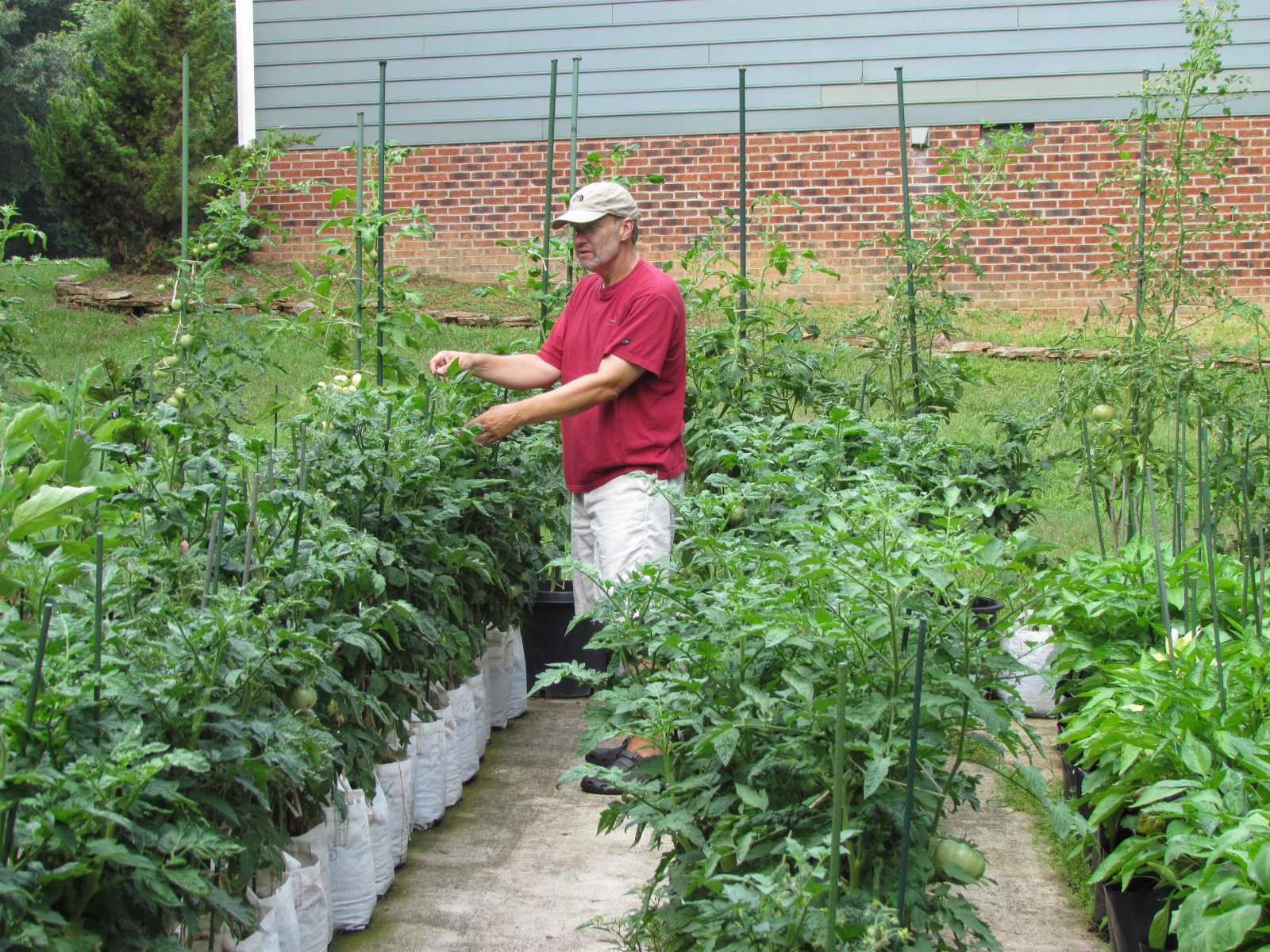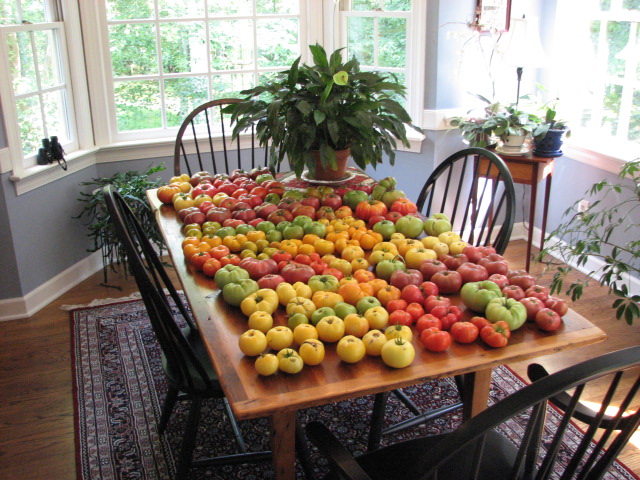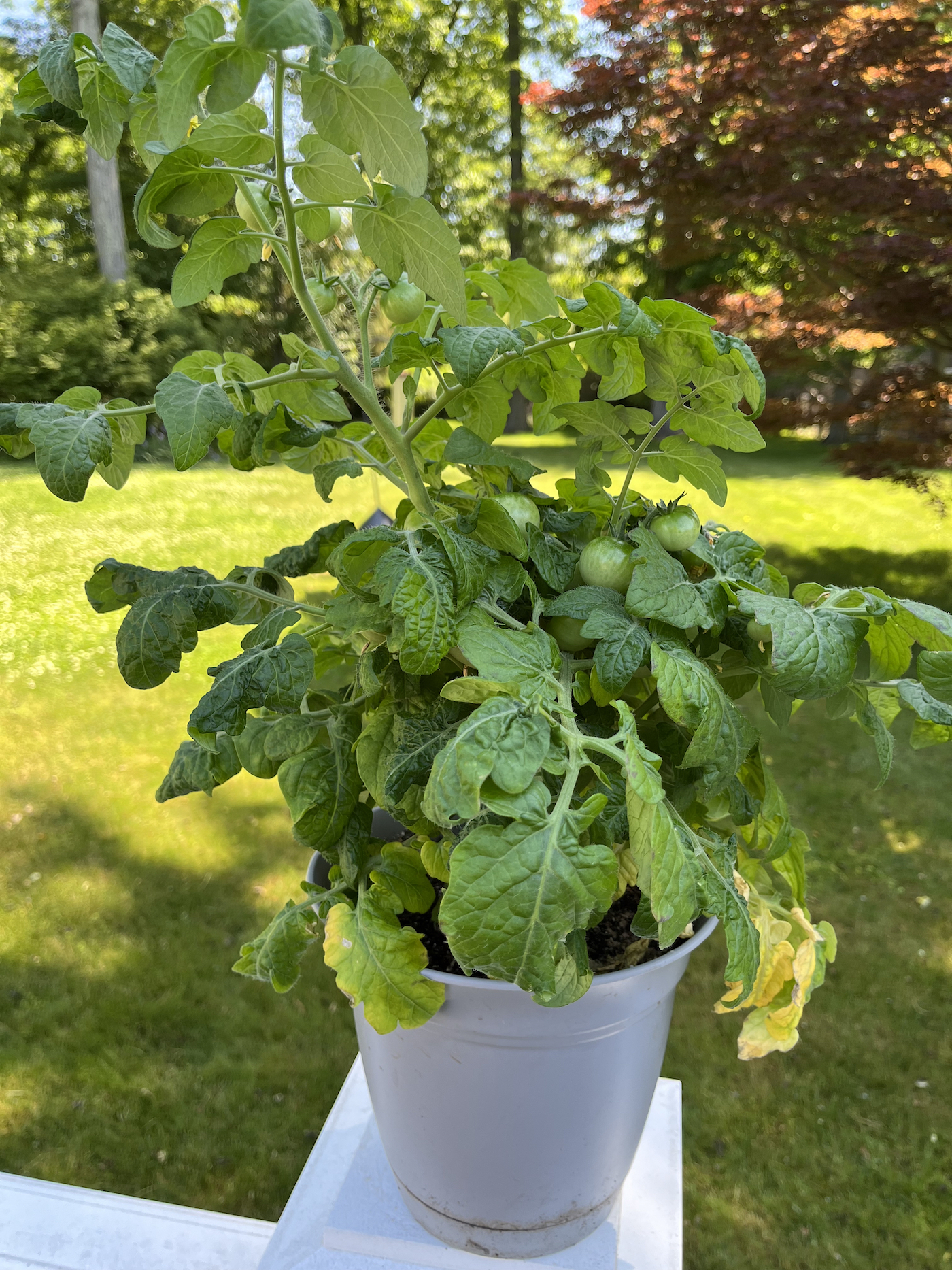Tomato Breeding Project Fueled By Over 1,000 Backyard Gardeners
11:56 minutes

In 2005, gardeners Craig LeHouiller and Patrina Nuske-Small created the Dwarf Tomato Project. They wanted to preserve the flavor and beauty of heirloom tomatoes, without taking up too much space. They started crossbreeding heirloom tomatoes with smaller dwarf tomato plants.
To do so, they enlisted volunteers from all over the world. Over 1,000 people have participated so far. You can even buy the seeds and plant them in your own garden!
Ira talks with the project’s co-founder, gardener and author, Craig LeHoullier, based in Hendersonville, North Carolina.


IRA FLATOW: My favorite time of the year is here– tomato season. Now, here in the Northeast, the ground has warmed up enough to plant those tomatoes. And you know what happens if you plant tomatoes, right? You know that the vines get to be really leggy. You have to find creative ways of wrangling these eight-foot long monsters.
So this year as I was planning my garden, I was delighted to come across a project that combines my love of gardening and doing science in my backyard and a solution to this vine challenge. It’s called the Dwarf Tomato Project and was started in 2005 by two gardeners, Craig LeHouiller and Patrina Nuske-Small. They decided to crossbreed heirloom tomatoes with smaller dwarf tomato plants, keeping that tasty tomato flavor of heirlooms, but taking up a lot less space in the garden.
And they enlisted volunteers from all over the world to help them to grow these. Over 1,000 people have participated so far. And I want to really get into this with Craig. Craig is here. He’s a gardener and author of the 2014 book Epic Tomatoes. He joins us from Hendersonville, North Carolina. Welcome to Science Friday.
CRAIG LEHOUILLER: Oh, thank you so much, Ira. It is an absolute delight to be here.
IRA FLATOW: You’re welcome. OK. Let’s start with the basics. What is a dwarf tomato compared to a standard variety?
CRAIG LEHOUILLER: Dwarf tomatoes are a very much lesser known genetic type of tomato. Indeterminants are the unruly children of the garden that go up and out and they need to be contained. Determinants, a lot of people know about them if they’ve grown Roma. What dwarfs are are a somewhat obscure variety that the genetics gives them a very thick central stem and a very beautiful, crinkly dark blue green foliage, as well as a characteristic where they grow upward at about half of the rate of the indeterminate types. And so an eight-foot Cherokee Purple will be a four-foot dwarf by the end of the season.
IRA FLATOW: Oh, love it.
CRAIG LEHOUILLER: I know. And the useless tomato cage is perfect for the dwarfs.
[LAUGHTER]
IRA FLATOW: And the tomatoes, are they smaller too, or are they normal size?
CRAIG LEHOUILLER: Well, of our 150 types and counting, we have everything from small cherries up to 1 to 1-and-1/4-pound fruit, every color you can imagine. We have those that are tart, those that are sweet, those that are intensely flavored. And running this project with Patrina in the last, gosh, 18 years– which is a hard thing to even conceive of– has been the most fun I have ever had during my 40 years of gardening.
IRA FLATOW: Tell us about that. How did you come up with the idea for the Dwarf Tomato Project? And why do you call it a project?
CRAIG LEHOUILLER: Sure. Well, you pretty much said why we came up with it. When we were selling seedlings in Raleigh, the most frequently asked question is, what do you have great that tastes incredible, but I can grow it in a pot, I don’t have to climb a ladder, I don’t have to take out my whip and tame the thing? And the answer in 2004 was– a few things, but not a heck of a lot.
So this was a niche that had been left to us. And Patrina and I corresponded on some garden chat sites. And she said, let me cross some tomatoes. Let’s pull a project together. And we just decided, let’s make it open source. Let’s tell people exactly what we’re doing, which varieties we’re crossing. Let’s enlist people who, once it’s made clear they’re not going to get paid very well– as in zero– that the reason they’re going to want to do this is they will learn a lot about tomato genetics. They will help create things that people are going to love to grow in their garden, particularly as container gardening became more important.
So we just ticked along. Made the first crosses in 2005. I distributed seeds out. We released our first ones in 2010.
IRA FLATOW: When you said you crossbred the tomatoes, you’re not talking GMO– you’re talking about pollinating each one by hand?
CRAIG LEHOUILLER: We’re talking Gregor Mendel. We’re talking going up to one of the indeterminate– or tall-growing, delicious ones– such as a Cherokee Purple, and collecting pollen from it using an electric toothbrush, and then going up to one of the few existing dwarfs at the time– as an interesting aside, the very first dwarf tomato appeared in an American seed catalog in 1850. But the tomato wasn’t very good on it. And nobody really took advantage of the fact they could breed different tomatoes to it, to upsize them and increase the flavor.
So we would go up to a dwarf and go to a flower and pull off the little anthers and expose the pistil, dip it into the pollen. If a tomato developed, we’d mark it. And that is the hybrid. That is the starting point. Each of our families starts with a hybrid. And those are the seeds of which we distribute. And that is the Forrest Gump box of chocolates. Because you never know what you’re going to get when you start growing out seeds from the hybrid.
IRA FLATOW: Is that why the volunteers grow them for you– to see what comes out?
CRAIG LEHOUILLER: Yeah. And so one of the attractions to this is, if you find a great-tasting unique dwarf, you get to name it. So we have cats and turtles and dogs, aunts, uncles, and flowers. And in America, there really is no stringent requirement to register names if you’re an amateur breeder. And then it goes through six to eight minimum generations of selections. Because you have to get rid of all of the things you don’t want. And you don’t get total stability.
If you find something great at the third or fourth generation, if you grow those seeds out, you’ll still see some noise. And you select for what you want. You keep doing that. And by the time you get to the sixth or eighth generation, the nice thing is you get a new, stable, open-pollinated variety that you could save seeds from, offer them to seed libraries. And then, in the catalog, your name will go in the description of the tomato that you helped develop.
So it really is citizen science. It really was, we felt, a unique way of doing this. And when I finish my book at the end of the year, I want to call it Crowd Breeding. Because to me it’s a new word, which is required, I think, for a new way of doing this type of collaborative breeding project.
IRA FLATOW: So these seeds can’t be patented? As you say, they’re open source.
CRAIG LEHOUILLER: Yes. Not only are they open source, we have pledged them to an organization, called OSSI, the Open Source Seed Initiative. And once seeds are pledged to them, they are available for people to improve, to do breeding with, but they’re not available to people to patent.
I think of these as some of tomorrow’s heirlooms. Meaning, in 30 or 40 or 50 years, if our great grandkids are growing Dwarf Sweet Sue or Dwarf Emerald Giant, they’ll probably be considered heirloom varieties. And as someone who loves genealogy and history and sharing and sending seeds, that warms my heart to think that these will just move on through gardens into the future.
IRA FLATOW: Do you have a favorite dwarf tomato variety?
CRAIG LEHOUILLER: Well, I have to say– my wife will listen to this– so I did name one of the best of all for my wife– Dwarf Sweet Sue. And it’s a 6 to 8 ounce beautiful yellow slicing tomato that has a little bit of a red blush on it. And the flavor, as is expected from the name, is on the sweet side, but it’s also very intense. And it grows well in lots of different areas of the country. So I really love Dwarf Sweet Sue and I love my wife as well. So it all works.
[LAUGHTER]
IRA FLATOW: If people want to find where they can get these seeds, where do they go?
CRAIG LEHOUILLER: So when we started distributing samples of seeds to the smaller seed companies, many of them love to do this, but they didn’t want to have their catalog taken over with the dwarf varieties. But Victory Seeds is incredible. And they have essentially dedicated themselves to offering every variety that we produce.
And what happens then, Ira, is other companies will decide, hey, these are doing pretty well. The reviews are great. They get the seeds from Victory, and then they offer them and their catalog.
An example, Dwarf Sweet Sue now, if you Google that, you can probably find it in 20 or 30 different seed companies around the world.
IRA FLATOW: Wow.
CRAIG LEHOUILLER: So this whole sharing, bottom-up approach of just letting word of mouth and the quality spread it around has worked very, very well.
IRA FLATOW: I need some pro tips from you before we go. And one of them would be– when is the best time to harvest your tomatoes? Let them ripen on the vine for the best flavor?
CRAIG LEHOUILLER: Well, most people love this concept of the vine-ripened tomato.
IRA FLATOW: Right.
CRAIG LEHOUILLER: And the problem with that is the tomato is– let’s say it’s fully ripe and it rains. It will crack. Let’s say that it’s fully ripe and it’s just smelling the whole garden up with aroma. And the passing deer or the passing rabbit or chipmunk or squirrel will say, sure, I’ll take a bite out of that.
So what we found is that you can let tomatoes get about half ripe. Which means halfway up from the blossom end, you’ll have color. From halfway up to the stem end, it will be pretty green. Pick those. Bring them into the house. Just leave them on the counter.
If you want, you can put an apple or a banana near them. Because they, as they ripen, give off ethylene gas. Ethylene gas is the hormone that causes tomatoes to fully ripen. Within three or four days, your tomatoes will be fully ripe. They won’t be cracked. And we’ve tested this in blind tastings– they will have a flavor fully equivalent to that if you were to let it get fully ripe on the vine.
And the other thing is they will have more shelf life. Because I don’t think there’s much more perishable than a fully vine-ripe tomato. They really need to be eaten in the garden, with juice dripping down your chin.
IRA FLATOW: Hard to follow that up with this last question. I know you’ve dedicated so much of your life to growing tomatoes and teaching others about them. What is it about tomatoes that keeps you coming back for more?
CRAIG LEHOUILLER: I have this memory of getting into a car with my grandparents when I was really young and driving to a farm stand, and them picking through the tomatoes, coming back to the backyard, having a cookout, and just slicing them up and putting them on the burgers. And so I think there is a strong nostalgic link to tomatoes.
I think there is such a diversity. There are actually at least 10,000 to 12,000 named varieties of tomatoes. And they are every shape, size, and color. And you get this incredible variation in flavors. All of that together, to me, makes it the perfect crop to fall in love with. And I think the tomatoes chose me. Because why else would JD Green have decided to send me this unknown purple tomato back in 1990 that I got to name Cherokee Purple? And everything has kind of followed from that.
So I’m just along for the ride on this, Ira. It’s the tomatoes that have decided to pluck me into the car with them.
IRA FLATOW: Well, you were ripe for the plucking it looks like.
CRAIG LEHOUILLER: Oh, my God. We’re going to have to stem this discussion.
[LAUGHTER]
IRA FLATOW: Craig, it’s been delightful. Thank you for enlightening us about this. We’re all going to go out and look for these seeds now.
CRAIG LEHOUILLER: Absolutely. My pleasure.
IRA FLATOW: Craig LeHouiller, gardener, author, and co-founder of the Dwarf Tomato Project, based in Hendersonville, North Carolina. And if you want to learn more about the project and see photos of these dwarf tomatoes, go to sciencefriday.com/tomatoes.
Copyright © 2023 Science Friday Initiative. All rights reserved. Science Friday transcripts are produced on a tight deadline by 3Play Media. Fidelity to the original aired/published audio or video file might vary, and text might be updated or amended in the future. For the authoritative record of Science Friday’s programming, please visit the original aired/published recording. For terms of use and more information, visit our policies pages at http://www.sciencefriday.com/about/policies/
Shoshannah Buxbaum is a producer for Science Friday. She’s particularly drawn to stories about health, psychology, and the environment. She’s a proud New Jersey native and will happily share her opinions on why the state is deserving of a little more love.
Ira Flatow is the founder and host of Science Friday. His green thumb has revived many an office plant at death’s door.